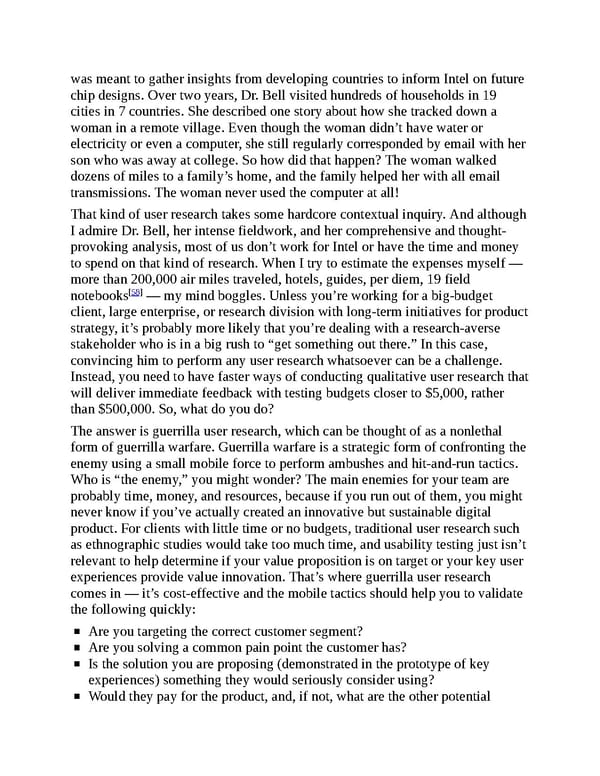was meant to gather insights from developing countries to inform Intel on future chip designs. Over two years, Dr. Bell visited hundreds of households in 19 cities in 7 countries. She described one story about how she tracked down a woman in a remote village. Even though the woman didn’t have water or electricity or even a computer, she still regularly corresponded by email with her son who was away at college. So how did that happen? The woman walked dozens of miles to a family’s home, and the family helped her with all email transmissions. The woman never used the computer at all! That kind of user research takes some hardcore contextual inquiry. And although I admire Dr. Bell, her intense fieldwork, and her comprehensive and thought- provoking analysis, most of us don’t work for Intel or have the time and money to spend on that kind of research. When I try to estimate the expenses myself — more than 200,000 air miles traveled, hotels, guides, per diem, 19 field [58] notebooks — my mind boggles. Unless you’re working for a big-budget client, large enterprise, or research division with long-term initiatives for product strategy, it’s probably more likely that you’re dealing with a research-averse stakeholder who is in a big rush to “get something out there.” In this case, convincing him to perform any user research whatsoever can be a challenge. Instead, you need to have faster ways of conducting qualitative user research that will deliver immediate feedback with testing budgets closer to $5,000, rather than $500,000. So, what do you do? The answer is guerrilla user research, which can be thought of as a nonlethal form of guerrilla warfare. Guerrilla warfare is a strategic form of confronting the enemy using a small mobile force to perform ambushes and hit-and-run tactics. Who is “the enemy,” you might wonder? The main enemies for your team are probably time, money, and resources, because if you run out of them, you might never know if you’ve actually created an innovative but sustainable digital product. For clients with little time or no budgets, traditional user research such as ethnographic studies would take too much time, and usability testing just isn’t relevant to help determine if your value proposition is on target or your key user experiences provide value innovation. That’s where guerrilla user research comes in — it’s cost-effective and the mobile tactics should help you to validate the following quickly: Are you targeting the correct customer segment? Are you solving a common pain point the customer has? Is the solution you are proposing (demonstrated in the prototype of key experiences) something they would seriously consider using? Would they pay for the product, and, if not, what are the other potential
 UX Strategy: How to Devise Innovative Digital Products that People Want Page 218 Page 220
UX Strategy: How to Devise Innovative Digital Products that People Want Page 218 Page 220